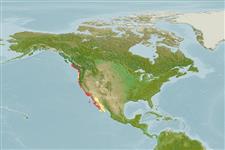Common names from other countries
>
Scombriformes (Mackerels) >
Stromateidae (Butterfishes)
Etymology: Peprilus: Greek, peprilos, paprax, certain fish from Tracia.
More on author: Ayres.
Environment: milieu / climate zone / depth range / distribution range
Ecologia
marinhas bentopelágico; intervalo de profundidade 9 - 91 m (Ref. 2850). Subtropical; 52°N - 23°N, 129°W - 109°W
Northeast Pacific: Queen Charlotte Sound in British Columbia, Canada to southern Baja California Sur and the Gulf of California. Occurrence in Nicaragua needs verification.
Tamanho / Peso / Idade
Maturity: Lm ? range ? - ? cm
Max length : 28.0 cm SL macho/indeterminado; (Ref. 9346)
Descrição breve
Chaves de identificação | Morfologia | Morfometria
Espinhos dorsais (total) : 3; Raios dorsais moles (total) : 45 - 47; Espinhos anais: 3; Raios anais moles: 39 - 44; Vértebras: 29. Brilliantly iridescent, green or blue above, silvery below; dusky on fins (Ref. 6885).
Commonly found on sand bottom of exposed coasts. Usually occurs in shallow water near shore and often forms small, but fairly dense, schools (Ref. 4563).
Life cycle and mating behavior
Maturities | Reprodução | Spawnings | Egg(s) | Fecundities | Larvas
Eschmeyer, W.N., E.S. Herald and H. Hammann, 1983. A field guide to Pacific coast fishes of North America. Boston (MA, USA): Houghton Mifflin Company. xii+336 p. (Ref. 2850)
Categoria na Lista Vermelha da IUCN (Ref. 130435)
CITES (Ref. 128078)
Not Evaluated
Ameaça para o homem
Harmless
Utilização humana
Pescarias: espécies comerciais; peixe desportivo: sim
Ferramentas
Relatórios especiais
Descarregue XML
Fontes da internet
Estimates based on models
Preferred temperature (Ref.
115969): 8.3 - 21, mean 10.1 (based on 54 cells).
Phylogenetic diversity index (Ref.
82804): PD
50 = 0.5020 [Uniqueness, from 0.5 = low to 2.0 = high].
Bayesian length-weight: a=0.01259 (0.00663 - 0.02390), b=3.11 (2.95 - 3.27), in cm Total Length, based on LWR estimates for this species & Genus-body shape (Ref.
93245).
Nível Trófico (Ref.
69278): 4.0 ±0.2 se; based on size and trophs of closest relatives
Resiliência (Ref.
120179): Elevada, tempo mínimo de duplicação da população menor que 15 meses (Assuming tm=1).
Fishing Vulnerability (Ref.
59153): Low vulnerability (24 of 100).
Climate Vulnerability (Ref.
125649): Moderate to high vulnerability (50 of 100).
